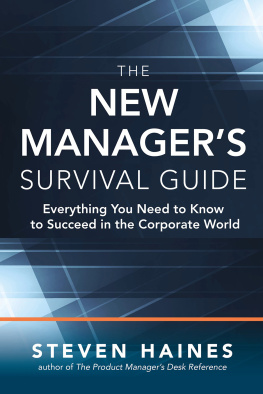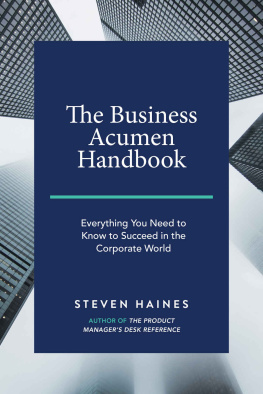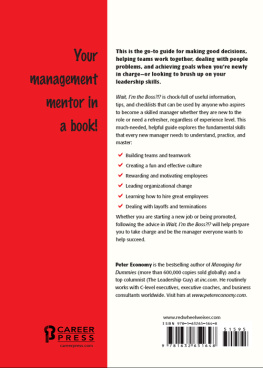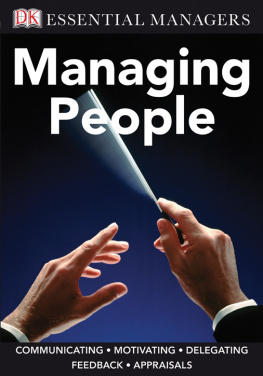Contents
Guide

THE NEW
MANAGERS
SURVIVAL GUIDE
Copyright 2016 by Steven Haines. All rights reserved. Printed in the United States of America. Except as permitted under the United States Copyright Act of 1976, no part of this publication may be reproduced or distributed in any form or by any means, or stored in a database or retrieval system, without the prior written permission of the publisher.
1 2 3 4 5 6 7 8 9 0 DOC/DOC 1 2 1 0 9 8 7 6 5
ISBN 978-1-259-58897-6
MHID 1-259-58897-1
e-ISBN 978-1-259-58976-8
e-MHID 1-259-58976-5
This publication is designed to provide accurate and authoritative information in regard to the subject matter covered. It is sold with the understanding that neither the author nor the publisher is engaged in rendering legal, accounting, securities trading, or other professional services. If legal advice or other expert assistance is required, the services of a competent professional person should be sought.
From a Declaration of Principles Jointly Adopted by a Committee of the American Bar Association and a Committee of Publishers and Associations
McGraw-Hill Education books are available at special quantity discounts to use as premiums and sales promotions or for use in corporate training programs. To contact a representative, please visit the Contact Us pages at www.mhprofessional.com.
CONTENTS
CHAPTER 1
STARTING OUT: ASSESSING YOUR BUSINESS ACUMEN
CHAPTER 2
FINDING YOUR WAY AROUND THE ORGANIZATION
CHAPTER 3
YOU CANT DO IT ALL YOURSELF
CHAPTER 4
MONEY IS NOT A FOREIGN LANGUAGE
CHAPTER 5
LEVERAGING PROCESSES TO GET THINGS DONE
CHAPTER 6
USING DATA TO SOLVE PROBLEMS AND MAKE DECISIONS
CHAPTER 7
MASTERING MARKETS
CHAPTER 8
SETTING DIRECTION WITH STRATEGY
CHAPTER 9
UNDERSTANDING PRODUCTS
CHAPTER 10
MARKETING: THE FULCRUM OF THE ORGANIZATION
CHAPTER 11
ASSESSING BUSINESS PERFORMANCE
CHAPTER 12
YOUR PROFESSIONAL DEVELOPMENT STRATEGY
FOREWORD
When I first read the manuscript for The New Managers Survival Guide, I asked myself two questions:
- Who exactly might benefit from this book?
- Who exactly might think that they would benefit from this book?
Although these questions are separated by just a few choice words, the differences in their meanings are vast.
Having spent over 20 years in the corporate world with a variety of different companies and in a number of different leadership positions, I immediately knew the answer to my first question. In a word: Everyone. This may seem like a dramatically overarching response, but in truth, I cant think of a single person, inside business or outside of it, who couldnt benefit by knowing the ins and outs of how a company operates.
For anyone who works inside a company, the information that will be shared within these pages will serve as an invaluable resource that would take most business professionals decades to learn on their ownif it even gets learned at all. Throughout my career, I have witnessed far too many business people who fail to gain perspectives and understandings outside of their own job functions and, as a result, fail to fully grasp how to effectively collaborate and interact outside the boundaries of their own departmental walls. It takes time, patience, and an innate curiosity to learn about what other functions do and, perhaps more important, why they do it. As such, this knowledge tends to be coveted by those select few individuals whose job it is to deeply understand and interact with multiple different departments on a very regular basis, or by those people who actively seek out such opportunities on their own. In the grand scheme of things, neither of these scenarios is terribly common within large organizations and, as a result, internal misalignment and miscommunication can be something of the rule rather than the exception.
For those people working outside of companies, nary a day goes by without someone asking the question, Why in the world did Company X, Y, or Z do that? Whether this question is asked from the perspective of a frustrated customer, a concerned supplier, or an inquisitive investor, it is quite common for people outside of an organization to not fully understand what makes a certain company tick or, perhaps more commonly, not tick quite as steadily as maybe it should. Not that understanding the root of any particular company issue will automatically make it go away; but it will certainly lessen the frustration of not knowing, and clear the path for a smoother, more fruitful interface that all concerned parties can more effectively benefit from in the long run. Practically everyone on earth deals with companies at some point in his or her life, so understanding how they work can only make that interaction more meaningful.
This book provides the foundational knowledge that most people, both inside and outside of companies, dont always have ready access to. So, within this context, answering everyone in response to my first question doesnt seem so out of range.
My second question, on the other hand, is a bit more difficult to address. Lets face it, the reason I asked the question of how many people might think they need this book is because I have a sneaking suspicion that this number may not be very highor at least not as high as it should be.
In my experience, I believe that most people in business instinctively know just how much they dont know about the way their companies operate. The problem is, some people in business might feel that they should know how a company operates and, therefore, they may be reluctant to fully admit when they dont. Couple that with the fact that deep learning takes time that may not always be in abundant supply, and you have a recipe for broad knowledge gaps not only to exist in business, but to actually widen as careers progress and responsibilities expand.
All of this brings me to my main concern, which is that new managers, or even aspiring ones for that matter, might be inclined to believe that they can learn everything they need to know on the job or, worse, that there might be some unwritten expectation of them to do just that. Of course, the fact that you have chosen to read this book indicates that you probably dont fall into this particular category. And it is for this very reason that I would like to ask for your help in two relatively simple ways as you work your way through the chapters that follow.
First, if you find the lessons in this book to be valuable, and you find that they provide you with insights that you did not previously have, then my first ask is simply that you apply whatever it is that you learn. I realize that many people will have picked up this book in order to advance their own careers, and, believe me, that is an honorable and worthwhile cause. But great careers also make great companies, which also happen to make great products. Applying the lessons you learn throughout this book will not only help you to enable your own career, it will also help you to enable this entire cycle. And the result of this is something that everyone can ultimately benefit fromemployees, companies, investors, and consumers alike.
My second ask is even easier than the first, and that is that you proudly tell your colleagues about what you learnand how you learned it. To be clear on this point, I am not directly asking you to promote this particular book (and I hope the fact that I am not the author of it helps to lend some credibility to this statement). Instead, I am asking you to promote the









